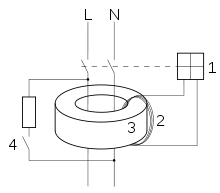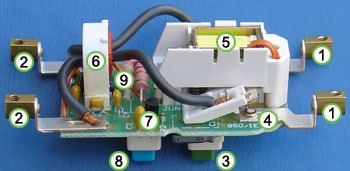conditions.
In the United States and Canada, a residual current device is also known as a ground fault circuit interrupter (GFCI), ground fault interrupter (GFI) or an appliance leakage current interrupter (ALCI). In Australia they are sometimes known as "safety switches" or simply "RCD" and in the United Kingdom, along with circuit breakers, they can be referred to as "trips" or "trip switches". In the previous edition of the IEE Electrical Wiring Regulations (16th Edition) they were used to add extra fault protection to socket outlets. The current edition (17th Edition) of the regulations state that all new installations, as well as a change of distribution board or the installation of new circuits in a property wired to any previous installation, must have a split load distribution board with two RCDs covering the installation, with upstairs and downstairs lighting and power circuits spread across both RCDs in case of a fault on one RCD, therefore leaving power to at least one lighting and power circuit.
Purpose and operation
RCDs are designed to prevent electrocution by detecting the leakage current, which can be far smaller (typically 5–30 milliamperes) than the currents needed to operate conventional circuit breakers or fuses (several amperes). RCDs are intended to operate within 25-40 milliseconds, before electric shock can drive the heart into ventricular fibrillation, the most common cause of death through electric shock.
In the United States, the National Electrical Code requires GFCI devices intended to protect people to interrupt the circuit if the leakage current exceeds a range of 4–6 mA of current (the trip setting is typically 5 mA) within 25 ms. A GFCI device which protects equipment (not people) is allowed to trip as high as 30 mA of current; this is known as an Equipment Protective Device (EPD). In Europe, the commonly used RCDs have trip currents of 10–300 mA.
RCDs operate by measuring the current balance between two conductors using a differential current transformer. This measures the difference between the current flowing out the live conductor and that returning through the neutral conductor. If these do not sum to zero, there is a leakage of current to somewhere else (to earth/ground, or to another circuit), and the device will open its contacts.
Residual current detection is complementary to over-current detection. Residual current detection cannot provide protection for overload or short-circuit currents.
RCDs with trip currents as high as 500 mA are sometimes deployed in environments (such as computing centers) where a lower threshold would carry an unacceptable risk of accidental trips. These high-current RCDs serve more as an additional fire-safety protection than as an effective protection against the risks of electrical shocks.
In some countries, two-wire (ungrounded) outlets may be replaced with three-wire GFCIs to protect against electrocution, and a grounding wire does not need to be supplied to that GFCI, but the outlet must be labeled as such. The GFCI manufacturers provide tags for the appropriate installation description.
Example
The photograph depicts the internal mechanism of a residual current device (RCD). The device pictured is designed to be wired in-line in an appliance power cord. It is rated to carry a maximum current of 13 amperes and is designed to trip on a leakage current of 30 mA. This is an active RCD; that is, it doesn't latch mechanically and therefore trips on power failure, a useful feature for equipment that could be dangerous on unexpected re-energisation.
The incoming supply and the neutral conductors are connected to the terminals at (1) and the outgoing load conductors are connected to the terminals at (2). The earth conductor (not shown) is connected through from supply to load uninterrupted.
When the reset button (3) is pressed the contacts ((4) and hidden behind (5)) close, allowing current to pass. The solenoid (5) keeps the contacts closed when the reset button is released.
The sense coil (6) is a differential current transformer which surrounds (but is not electrically connected to) the live and neutral conductors. In normal operation, all the current down the live conductor returns up the neutral conductor. The currents in the two conductors are therefore equal and opposite and cancel each other out.
Any fault to earth (for example caused by a person touching a live component in the attached appliance) causes some of the current to take a different return path which means there is an imbalance (difference) in the current in the two conductors (single phase case), or, more generally, a nonzero sum of currents from among various conductors (for example, three phase conductors and one neutral conductor).
This difference causes a current in the sense coil (6) which is picked up by the sense circuitry (7). The sense circuitry then removes power from the solenoid (5) and the contacts (4) are forced apart by a spring, cutting off the electricity supply to the appliance.
The device is designed so that the current is interrupted in a fraction of a second, greatly reducing the chances of a dangerous electric shock being received.
The test button (8) allows the correct operation of the device to be verified by passing a small current through the orange test wire (9). This simulates a fault by creating an imbalance in the sense coil. If the RCD does not trip when this button is pressed then the device must be replaced.
Three-phase example
For a three-phase variant all live conductors and the neutral must pass through the current transformer.
Rules and regulations
Rules and regulations differ widely from country to country. In Europe, the UK has only mandated the use of RCDs in new installations since July 2008. In contrast, Germany requires the use of RCDs on sockets up to 20A which are for general use. This rule was introduced in June 2007 (DIN VDE 0100-410 Nr. 411.3.3). In Norway, it has been required in all new homes since 2002, and on all new sockets since 2006. In Australia, they have been mandatory in all new houses since 1991 on all power and lighting circuits[1]. In the U.S., the National Electrical Code requires GFCIs for underwater swimming pool lights (1968); construction sites (1974); bathrooms and outdoor areas (1975); garages (1978); near hot tubs or spas (1981); hotel bathrooms (1984); kitchen counter receptacles (1987, revised 1996 and specifically excluding the refrigerator outlet, which is usually on a dedicated circuit); crawl spaces and unfinished basements (1990); wet bar sinks (1993); laundry sinks (2005).[2]
Use and placement

In most countries, not all circuits in a home are protected by RCDs. If a single RCD is installed for an entire electrical installation, any fault will cut all power to the premises. Normal practice in domestic installations in the UK[citation needed] was to use a single RCD for all RCD protected circuits but to have some circuits that are not protected at all (sockets usually are on the RCD; lamp holders usually aren't; other circuits vary by who installed the system). Regulation introduced in 2008 dictate that on all new electrical installations in the UK, all circuits must be protected by an RCD[citation needed] however, this does not affect existing installations.
GFI receptacles in the USA have connections to protect downstream receptacles so that all outlets on a circuit may be protected by one GFI outlet.
Source:en.wikipedia.org/





No comments:
Post a Comment